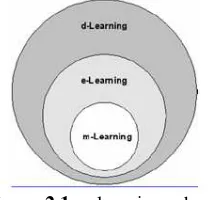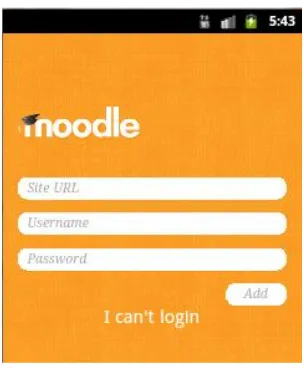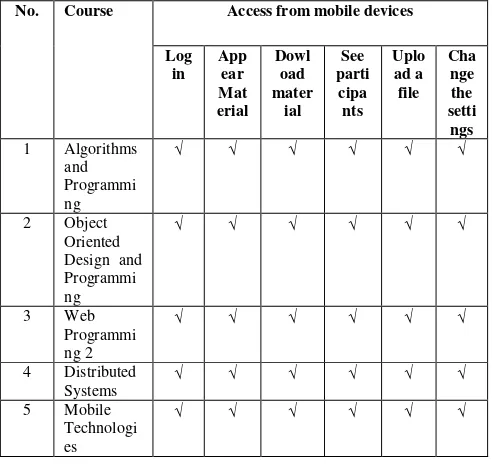Design of A Learning Management System
for Mobile Media
Abstract - This paper discusses design of m-learning system which is extension of an e-learning system that can be accessed using mobile device. This system can be used as media to deliver the course materials and as an interaction channel between students and lecturer in mobile environment.
Four sequential steps were conducted in this study. First, analysis of the system requirement, and then design of architecture and user management of the system performed. After that, system design was implemented by installing and configuring the LMS (Learning Management System) application as server and mobile client application to access thus LMS. Finally, system was tested its functionality.
The learning system that was developed based on LMS Moodle as a server and Moodle Mobile as a client in Android-based mobile devices have been able to run according to its function and can be used to support learning by providing materials that can be uploaded and downloaded
Keywords : LMS, e-learning, m-learning
1
Introduction
Mobile device technology has affected various aspects of public life in recent years. This new technology has also gradually affecting education in order to expand opportunities for learning and training process. The emergence of mobile technology in education seems timely, given the current needs in the study, namely: access to learning materials more widely and more quickly and the need to communicate quickly and continuously. Thus, the learning process of organizing institutions must find ways to improve and to cope with the new demands of the learning process. Not surprisingly, many new technologies being explored by many organizations to improve the provision of a better learning environment for stakeholders, namely students and educators and the community. (Keegan, 2002)
One example of the application of new technologies in the learning process is E-learning, a system that has changed the learning process, from which only limited in a classroom environment at school became an almost unlimited scope that is on the internet involving more participants and learning materials more varied with a
range of delivery media more accessible. Another benefit of E-learning is the cost efficiency in learning, especially for cases where the students are away from the providers of education or training, so that the learning process can be done independently without having to always do face to face directly. Teachers also can still monitor the progress of their students and communicate via the Internet.
E-learning has evolved rapidly and it is supported by the development of information and communication technology infrastructure, which is increasingly fast and affordable. Needs of e-learning users are now beginning to shift as a lifestyle change, which requires people to do more mobility. Users should be able to access e-learning without having to settle in one place, but also when moving to another place.
The development of mobile devices is now increasingly sophisticated with the presence of smart phones and tablets that allows users to access information more quickly and more practical without having to be stuck in one place.
With the rapid development of mobile devices, mobile learning systems or m-learning is developed, which has a similar concept with e-learning, but has been adapted to the specifications of mobile devices, which has several limitations in contrast to ease owned, including screen size relatively small compared to PCs or laptops in general.
2
Theoretical Background
2.1
M-Learning Definition
The term mobile learning appears to refer to the use of handheld devices and mobile information technologies, such as PDAs , mobile phones , laptops or tablet PCs , in teaching and learning activities . However, for the definition of m-learning , there are several definitions . M - Learning is any kind of learning where the learner is not at a fixed location or predetermined , or learning in which learners take advantage of mobile technology ( Mobilearn , 2003) or other definitions are: M - Learning is the intersection of mobile computing and e - Learning . The sources can be accessed from anywhere, search capabilities and strong support, rich interactions, for effective learning and assessment based on performance. E-Learning itself has the independence of space and time
Arif Rahman
Information Systems Department, Ahmad Dahlan University
Jl. Prof. Supomo, Yogyakarta 55164, Tel. (0274) 381523, 379 418
(Quinn, 2000). M - Learning is part of the electronic learning (e-learning) so that, by itself, is also part of the distance learning (d -learning) which can be described in Figure II.1 ( Georgiev et al , 2004)
Figure 2.1 m-learning scheme
Some of the important capabilities that must be provided by m-Learning is the ability to connect to other devices, especially computers, the ability of learning and the ability to present information to realize bilateral communication between teachers and learners. M-Learning is a unique learning because learners can access learning materials, referrals and applications related to learning, anytime and anywhere. This will increase the focus on learning materials; making learning becomes pervasive, and can encourage learners' motivation to lifelong learning. In addition, compared to conventional learning, m-learning allows for more opportunities for collaboration in ad hoc and informal interaction among learners.
2.2 Classification of M-Learning
M-Learning in different viewpoints can be classified into several parts (Georgiev et al, 2005). In terms of information and communication technologies, m-learning can be classified based on the following main indicators: (i) the type of supported mobile devices (notebooks, TabletPC, PDA, mobile phones or smart phones) and (ii) the type of wireless communication that is used to access learning materials and administrative information (GPRS, GSM, IEEE 802.11, Bluetooth, IrDA).
Classification of m-learning from a technological point of teaching based on the following key indicators: (i) support or synchronous and asynchronous learning, (ii) support e-learning standards, (iii) the availability of a permanent internet connection between m-learning system and users, (iv) the location of the user and (v) access to learning materials and / or administrative services.
According to the time of teachers and students share information, m-learning can be classified into: (i) a system that supports synchronous learning system that is capable of supporting students to be able to communicate with teachers and other students in real time. For that purpose, voice communications, video chat or communication can be used (ii) systems that support asynchronous learning. In this system students can not communicate in real time with the teacher and other students. E-mail and SMS are often used to exchange information in this system (iii) a system that supports
synchronous and asynchronous learning at the same time. Classification can be described in Figure II.2
Figure 2.2. Classification of m-learning system (Georgiev et al, 2005)
2.3 Components of M-Learning
M-learning component includes three aspects, which interact with each other to achieve successful learning with mobile device technology, these three aspects are (Sulisworo, 2012)
2.3.1 Devices Aspects
Aspect refers to the physical characteristics, technical, and functional mobile devices. Physical characteristics include the ability to input/output, storage, power, processor speed, compatibility and the ability to be upgraded. These characteristics result from the design of hardware and software and have a significant impact on the physical and psychological comfort level of the users. These characteristics are important, because the mobile device is the interface between student and the learning task. Appropriate device will support successful learning. 2.3.2 Students Aspects
Aspects of students include individual cognitive abilities, memory, prior knowledge, emotion and motivation. This aspect describes how students use what they already know and how they translate, remembering and transferring information.
2.3.3 Social Aspects
Social aspects describe the process of social interaction and cooperation. These individuals must comply with the rules that have been agreed to communicate and in accordance with the existing culture so that students can exchange information and gain knowledge. In mobile learning culture can be physical and virtual.
3
Discussion
3.1. System Analysis
Learning with e-learning applications need to manage the administration, contents, and documentation of e-learning. Application to manage e-learning is a LMS (Learning Management System). this time, the majority of LMS web application developed in an environment that is technologically ready to go online.
is related to the limited size of the display on the mobile device so that not all the user interface can be displayed with the perfect and convenient to use. In addition, the limited computational capabilities that cause the processing time become relatively longer.
The conclusion that can be drawn from the above review that is, to develop m-learning LMS is needed, which supports accessing content by mobile devices, so in addition to using a computer that has a relatively limited mobility, users can access anytime, anywhere with mobile devices
3.1.1 Specification of LMS
There are currently many options for LMS applications, for personal or small organizations to large or enterprise-class institution, which has simple features to complete and advanced features. Survey LMS users on the Internet can help to determine which LMS will be used. One of the surveys is: The Top 20 Most Popular LMS Software Solution by Capterra (capterra.com, 2013). Moodle (Modular Object-Oriented Dynamic Learning Environment) which is an LMS in the category of FOSS (Free and Open Source Software) ranked number one among others.
Besides popularity and simplicity, completeness of features and user support is a factor that must be considered. Moodle also has comprehensive features, including support for mobile learning
3.1.2 Specification M-Learning Applications
M-learning application is an application that is installed and run on mobile devices. M-learning applications as well as mobile applications can be a launcher / caller to the address of the mobile web server, or a native app created specifically for particular mobile device platforms, eg Android or Apple iOS. Moodle has been providing a mobile version called Moodle Mobile for mobile learning management integrated with the LMS server. These applications can run on the Android platform and Apple's iOS (docs.moodle.org, 2013) 3.2. SYSTEM DESIGN
The design of m-learning systems in this study refers to the results of the analysis in the previous section. Designing learning systems with mobile devices consists of architectural design and management of learning. 3.2.1 System Architecture
Mobile device-based learning system is essentially a web-based application that can be accessed through the mobile platform. So technically there is no much difference with a web application that runs on the web server. This system also requires the management of application data in the database server. M-learning system architecture in this study is shown in Figure 3.1
Server Mobile Learning Client
Client
client
Administrator Database
E-learning
Figure 3.1 M-learning system architecture
The Mobile Learning server consists of the LMS as a server for mobile learning applications that run on a web server and a database server for data storage LMS server. Management system by the administrator is performed through a web application, and in this architecture, the user m-learning acts as a client that can access from mobile devices.
3.2.1 User Management
M-learning server provides services to the client mobile device, so it must be ensured that the server computer is connected to the public network that can be accessed by a mobile device that has different connection providers. Network and application security factors need to be considered. M-learning system uses user password protection.
User authority settings also need to be considered to maintain the security of the system. Each user has a role in the system, related to the authority in the system. List of user roles in this system is shown in Table 3.1
Table 3.1 List of user roles
No. Role Information
1
Manager
Managers can access and modify the course, generally do not participate in the course.
2 Author
courses Course creator can create a new course. 3
Teacher
Teachers can do anything on the course, including changing the activities and assess students.
4
Teachers who do not edit
Teachers are not able to edit (non-editing teachers) can teach in a course and assess students, but cannot change the activity.
5
Student Students generally have fewer rights in the course.
6
Guest Guests have minimal privileges and usually cannot enter text anywhere. 7 Authenticated
3.3 SYSTEM IMPLEMENTATION
The design of m-learning system that has been made, will be implemented so that it can be used for its intended, to support mobile learning. Implementation conducted by performing the steps of installation and configuration. First step is to install the LMS server, in this study, Moodle is selected and m-learning applications to be installed on mobile devices is Moodle Mobile. Implementation of the system is shown in Figure 3.2
Web Server
Apache
LMS
Moodle
Database MySQL
Client
Moodle Mobile
Client
Moodle Mobile
Administrator
Figure 3.2 System implementation diagram
IV.3.1 System Installation
System Installation step begins with the installation of Web Server software, this study selected the Apache 2.0 Web Server. Then, proceed with the installation of the programming language PHP 5.3. The web server must be setup in order to communicate with PHP. After that, the database server MySQL 5.x is also installing.
The next step is to install Moodle 2.4 LMS server, which downloaded first. Moodle also require adjustment of the configuration settings to a MySQL database connection, by editing the config.php file. If you have successfully installed, if calling from a browser, the display appears as in Figure 3. 3
Figure 3. 3 Examples of Moodle Main Page
After LMS Server is installed and running properly, then Moodle Mobile app on mobile device is installed. A mobile device with Android platform 2.3 and above is selected in this experiment. Moodle Mobile app can be downloaded for further installed via Android's app repository is Google Play Store (play.google.com). If you have successfully installed and executed in a mobile device will appear as in Figure 3.4
Figure 3.4 The initial view of Moodle Mobile
3.3.2 System Configuration
Configuration settings in the LMS can only performed by an administrator who has been registered in the system. Administrator who has logged into the system can activate the Mobile Web Service in Moodle through the menu Administration Site - Plugins - Web Services - Mobile. Then Enable Web services for mobile devices as in Figure 3.5
Figure 3.5 Mobile Web Service Settings in Moodle
The next step is to add the course. The subjects to be put into a category, if not already there, then made first. If the course has been made, then add the course material that can be grouped based on the date of the meeting. In addition to learning materials, the task file links can also be added, as shown in Fig. 3.6 appear as in Figure 3.4
4 SYSTEM TESTING
The system that had been installed and configured then tested whether system could run according to its function. Testing is performed by adding 5 courses and adding course materials for five weeks or meetings in the LMS server, and then accessed from mobile devices which have Moodle Mobile installed. The test results are expressed in Table 3.2
Table 3.2 The results of the testing of mobile devices accessing
No. Course Access from mobile devices
Log
Table 3.2 shows that for the LMS features: Login, display course materials, content downloading, uploading files and changing the setting material has been successfully accessed by the user through the Moodle Mobile program installed on Android-based mobile devices
4
Conclusions
From the analysis, design, implementation and testing in this study it can be concluded that: (i) m-learning system that was developed based on Learning Management System Moodle as a server and Moodle Mobile as a client in Android-based mobile devices have been able to run according to its function. (ii) m-learning system can be used to support learning by providing materials that can be downloaded and users can upload course files or task.
Bibliography
Capterra.com The Top 20 Most Popular LMS Software Solution. Accessed 29/11/2013
Georgiev, T., Georgieva E, Smrikarov A. 2004. M-Learning - a New Stage of EM-Learning, International Conference on Computer Systems and Technologies. Georgiev, Tsvetozar, Georgieva E, Smrikarov A.2005. A General Classification of Mobile Learning Systems, International Conference on Computer Systems and Technologies.
Holzinger, Andreas, Nischelwitzer A, M Meisenberger 2005. Mobile Phones as a Challenge for m-Learning: Experiences with the Mobile Learning Engine (MLE) using Mobile Interactive Learning Objects (Milos), h ttp
:/ /
dmt.fhjoanneum.at/kd3/objects/application_pdf/percom20 04% 20haw aii_PerIL_ah_nis.pdf
Keegan, D. 2002. The future of learning: From e-learning to MLearning. R etrieved September 7th, 2002 from WWW:
http://learning.ericsson.net/leonardo/thebook/chapter4.h tml # milearn
MOBIlearn.2003. Guidelines for Learning / Teaching / Tutoring in a Mobile Environment.
http://www.mobilearn.org/download/results/ guidelines.pdf. Accessed 05/06/2009
Moodle.org. , 2013. Moodle Documentation. Retrieved 29 November 2013
Quinn, C., 2000. M-Learning: Mobile, Wireless, In-Your-Pocket Learning. In LiNE Zine, Fall. www.linezine.com/2.1/features / cqmmwiyp.htm. Accessed 18/12/2008
Sharples M, Taylor J, Vavoula G., 2005. Towards a Theory of Mobile Learning. Proceedings of the 2005 Conference MLearn.
Sulisworo D, 2012. The pedagogical model of conceptual development of the M- long live learning to support education flexibility. IC-GWBT2012, Ahmad Dahlan University.
Tamimuddin, M.H, .2007. Know Your Mobile Learning, Limas Edition 18, limas.p4tkmatematika.com



